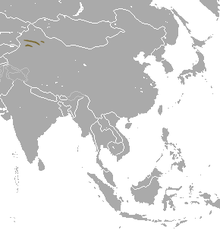Ili pika
| Ili pika | |
|---|---|
| Scientific classification | |
| Kingdom: | |
| Phylum: | |
| Class: | |
| Order: | |
| Family: | |
| Genus: | |
| Species: | O. iliensis
|
| Binomial name | |
| Ochotona iliensis Li & Ma, 1986
| |

| |
| Ili pika range | |
The Ili pika (Ochotona iliensis) is a species of mammal in the Ochotonidae family, endemic to northwest China. The total length of O. iliensis is 20.3–20.4 cm.[2]
Range
It is endemic to the Tian Shan mountains of northwest Chinese province Xinjiang. A recent census indicated that Ochotona iliensis may be extirpated from Jilimalale and Hutubi South Mountains.[3]
Habitat
Ochotona iliensis inhabits talus areas on high cliff faces. This species constructs haypiles and is a generalized herbivore.[3]
Ecology
Almost nothing is known about the ecology or behavior of the species.[4]
O. iliensis exhibits low population densities. It is mostly a diurnal species, but may exhibit nocturnal activity. Only one to two litters are produced each year, but litter size for this species is unknown.[3]
Conservation
The animal which resembles a rabbit was first observed by conservationist Li Weidong in 1983. After three years of research, Mr Li and his team named it the Ili Pika, after the area where it is found, the Ili Prefecture on the far west side of China's Xinjiang province.
Its population has been reduced by 70% within 15 years. Population declines have been observed for several locations inhabited by this species. A recent census indicated that Ochotona iliensis may be extirpated from Jilimalale and Hutubi South Mountains. Populations have declined in the regions of Jipuk, Tianger Apex, and Telimani Daban. Only one examined site, the Bayingou region of Xinjiang Uygur, showed signs of previously observed abundance. An estimated 2,000 mature individuals existed in the early 1990s.[5] The exact causes for recently observed population declines are not known, but it is speculated that an increase in grazing pressure and global atmospheric pollution resulting in climate change are negatively affecting Ochotona iliensis populations. Low population densities and reproductive rates coupled with the relatively limited ability to disperse impede the ability of the species to recover from declines. There are no known conservation measures in place for Ochotona iliensis.[3]
See also
References
- ^ Template:IUCN2008 Database entry includes a brief justification of why this species is of endangered.
- ^ Smith, A.T., & Xie, Y. (2008). The Mammals of China. Princeton University Press, Princeton, New Jersey.
{{cite book}}: CS1 maint: multiple names: authors list (link) - ^ a b c d Li, W. & Smith, A.T. (2005). "Dramatic decline of the threatened Ili pika Ochotona iliensis (Lagomorpha: Ochotonidae) in Xinjiang, China". Oryx. 39: 30–34. doi:10.1017/s0030605305000062.
{{cite journal}}: CS1 maint: multiple names: authors list (link) - ^ Smith, A.T., & Xie, Y. (1990). "Chapter 3: The Pikas". Rabbits, Hares and Pikas: Status Survey and Conservation Action Plan. The World Conservation Union, Gland, Switzerland.
{{cite book}}: Unknown parameter|editors=ignored (|editor=suggested) (help)CS1 maint: multiple names: authors list (link) - ^ https://www.thedodo.com/teddy-bear-animal-1055111645.html

